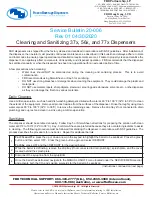
12
Maximizer
®
97 Owner’s Manual
OR-05/18/15
Quality Water International
®
Valve Overview
Bypass Valve Overview
Blending Dial Overview
The bypass valve can isolate the appliance should the appliance malfunction or leak. It can also permit the use of
untreated water for watering plants, shrubs, or lawns.
The bypass valve is attached to the main control valve.
See Figure 3
. To engage the bypass valve, locate the blue knob
on top of the bypass valve. Turn the knob counterclockwise until it hits the stop. The appliance will be bypassed and all
water to the home is raw, untreated water. To prevent untreated water from entering the home, water should not be used
inside the home when the appliance is in Bypass mode. Ensure that the appliance is returned to Service mode when the
appliance is repaired or the use of untreated water is complete by turning the blue knob clockwise until it hits the stop.
In some situations, the blending valve may be used to decrease water softness. The amount of hardness blended back
into the water line is determined by the hardness of the incoming water and the setting of the blending valve. Where
extremely hard water is present, the blending valve may only need to be “cracked” open. Where the incoming water has
relatively low levels of hardness, the blending valve will need to be opened further.
The blending valve is located between the input and output connections on the top of the bypass valve. (
see Figure 2)
.
It is adjusted by placing a flat blade screwdriver in the slot provided and turning clockwise to open. Total movement of
the blending valve from full closed to full open is 1/4 revolution. Precise setting of the blending valve will require “trial and
error” testing. The initial setting should be conservative. Because of the blending valve’s ease of access and adjustment,
the user can increase or decrease the setting according to their preference over a period of time.
Use of the blending valve is not recommended where objectionable concentrations of ferrous iron or sediment are
present. Because the blending valve is mixing “raw” water with softened, any ferrous iron or sediment in the “raw” water
will also be blended and reintroduced into the softened water line.
Note: If the appliance is installed for barium and/or radium reduction, the blending valve must remain in the fully closed
position at all times.
Bypass Knob
Blending Valve
Figure 2: Bypass Valve
Test Port
Drain Connection
(1/2-inch FNPT)
Main Control Valve













































